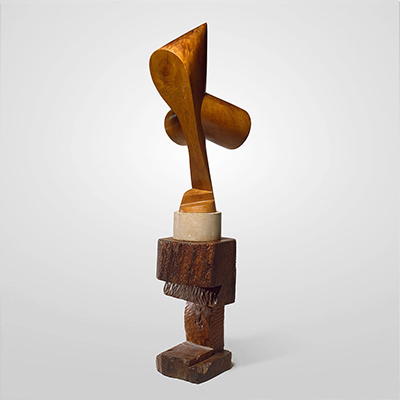Constantin Brancusi is still remembered for his intricate idealisation of the aesthetic form plus the integration of furniture, sculpture, and architecture including the spiritual thought's poetic evocation in his art pieces.
This was primarily attributed to his tendency to lean towards Expressionism, which made him carve out unique objects. Even though most of his metal or stone creations were a representation of archetypal forms like sleeping figures and birds, most of his works using wood mostly represented spiritual entities or specific characters. The Sorceress is interpreted as a flying witch, which was mostly described in many Romanian tales. The sculpture was mostly surrounded by an air of mystery because Brancusi seldom revealed where his visual inspirations came from or the origins of his visions.
Brancusi was able to impressively manifest the element of volume in space in a seemingly non-figurative way. This helped him bring out the true character of The Sorceress, a style that he was able to pick up from Auguste Rodin. He was able to accentuate the muscularity of the sculpture to enable him to communicate the spirit and power of the subject in this sculpture. It is clear that he rejected the realistic form to come up with a more abstracted depiction of a sorceress to communicate his ideology of "the inner hidden reality".
He preferred carving out his pieces by hand and The Sorceress was no different. This enabled him to achieve the abstracted appearance of the subject, an expression of his artistic vision. That is why the surface of the piece appears to be smooth and shiny because he took immense care while tending to the surfaces.
Brancusi's style as depicted on The Sorceress was mostly inspired by Paul Gauguin. He was the reason Brancusi was motivated to study tribal art, which was evidenced by the patterns that were typical to African carvings. Paul Gauguin also played an instrumental role in Brancusi’s use of overt sexual references that were mostly inspired by primitive fetishes. Apart from Gauguin, other notable artists played a crucial role in shaping Brancusi's career including Auguste Rodin and Marcel Duchamp plus friends like Henri Rousseau.
Constantin Brancusi played a significant role in changing the direction of such art movements as Art Deco and Minimalism. Furthermore, he also influenced great names in art history like Robert Morris, Richard Serra, Donald Judd, and Isamu Noguchi plus friends like Ezra Pound and Amedeo Modigliani.




